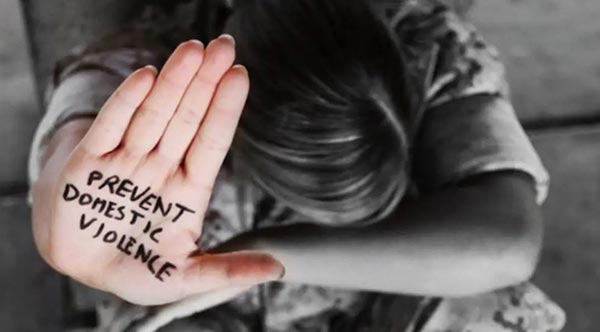Domestic Violence

Domestic abuse is a pattern of coercive, controlling behavior that is a pervasive life-threatening crime affecting people in all our communities regardless of gender, age, sexual orientation, race, ethnicity, religion, social standing and immigration status. Domestic violence usually refers to abuse mostly occurring in between a romantically attached partner; where one of them abuses the other. But it also expands to a family member abusing the other.
Women are generally the victims of Domestic Abuse. This is mostly because women and men are not treated as equals.
Men have been considered the superior ones since the dawn of age, and women as the subordinate ones. As a result, many men abuse their advantages of having the dominant role in the society and many women are the victims of the abuse.
Domestic violence is mostly seen in marital relationships. One of the partners abuse the other through multiple forms including physical aggression or assault (hitting, kicking, biting, shoving, restraining, slapping, throwing objects, beating up, etc.), or threats thereof; sexual abuse; controlling or domineering; intimidation; stalking; passive/covert abuse (e.g. neglect); and economic deprivation. It can also mean endangerment, criminal coercion, kidnapping, unlawful imprisonment, trespassing, and harassment. Besides, a victim can be financially abused. Financial abuse involves controlling a victim’s ability to acquire, use, and maintain financial resources. Those who are victimized financially may be prevented from working.
Domestic violence has been a staple aspect of the society of our country. The toxicity of patriarchy in our society has led to this downfall. Although female empowerment and gender equality has improved the social standard of the women of Bangladesh during recent times, domestic violence still prevails in many houses of our country. In many cases, a husband beats up his wife, which is a form of physical abuse, as the wife fails to fulfil his unusually absurd expectations, which is the cause of emotional abuse itself. Besides, due to the society’s high expectations, a woman is expected to serve her in-laws for some years at least, if not for the rest of her life, causing psychological distress to her. In many cases, if the girl’s family fails to provide her in-laws’ family with a considerable amount of dowry, the girl has to suffer verbal and sometimes physical abuse by her in-laws’ family. A woman sometimes falls victim to sexual abuse, more precisely marital rape, which is still legal in Bangladesh in accordance to law.
Domestic violence mostly happens due to the possessive and abusive nature of a person, but society and culture also plays a huge role in this, as patriarchy is provoked and a male abusing a female has been normalised by the male dominant society. The historical nature of gender-based violence confirms that it is not an unfortunate aberration but systematically entrenched in culture and society, reinforced and powered by patriarchy. Patriarchy is the structural force that influences power relations, whether they are abusive or not. Patriarchal beliefs of male, heterosexual dominance and the devaluation of girls and women lie at the root of gender-based violence. Culture is used to justify gender inequality and violence by evoking traditional cultural beliefs about how women should be treated. The defense of the culture of a place, country, religion, etc., is in fact a defense of the culture of patriarchy in that country, religion, identity; and the culture of violence everywhere. The culture of patriarchy is not static: its manifestation on an army base differs from that in a rural town.
Violence against women maintains the structures of gender oppression; be it carried out by individuals in private and/or by institutional forces in the public sphere. Whilst violence commands greater attention and fear; sexism and misogyny do their share to shape inequality, by defining and upholding restrictive gender norms.
Violence against women has long-term effects on the victims. Violence or abuse in any form has serious health consequences. It can lead to negative health outcomes such as chronic pain, increased risk of stroke, heart disease, lung disease, diabetes, cancer, or gynecological problems. There are also behavioral health concerns like depression, alcohol and substance abuse, and high-risk sexual behaviors. Additionally, domestic violence is linked to absenteeism and poor performance in the workplace, which may result in social isolation, housing and financial concerns, and further health risks for the victims and their families.
The relationship between Islam and domestic violence is disputed. Even among Muslims, the uses and interpretations of Sharia, the moral code and religious law of Islam, lack consensus. Variations in interpretation are due to different schools of Islamic jurisprudence, histories and politics of religious institutions, conversions, reforms, and education.
Domestic violence among the Muslim community is considered a complicated human rights issue due to varying legal remedies for women by the nations where they live, the extent to which they have support or opportunities to divorce their husbands, cultural stigma to hide evidence of abuse, and inability to have abuse recognized by police or the judicial system in some Muslim nations.
There are several strategies that are being used to attempt to prevent or reduce domestic violence. It is important to assess the effectiveness of a strategy that is being implemented. Gender norms that promote the inferiority of women may lead to the abuse of women by intimate partners. The WHO writes that, “Dismantling hierarchical constructions of masculinity and femininity predicated on the control of women, and eliminating the structural factors that support inequalities are likely to make a significant contribution to preventing intimate partner and sexual violence”. Therefore, it has been a mandatory aspect to ensure gender equality in all sectors of life, and get rid of the old-school gender biased judgment of the society.
Besides, strategies to promote healthy, respectful, and nonviolent relationships are an important part of prevention. Programs that teach young people healthy relationship skills such as communication, effectively managing feelings, and problem-solving can prevent domestic violence. According to the Centers for Disease Control and Prevention, “A key strategy in preventing [Domestic Violence] is the promotion of respectful, nonviolent relationships through individual, community, and societal level change”. Early intervention programs, such as school-based programs to prevent dating violence are also effective. Children who grow up in violent homes may be led to believe that such behavior is a normal part of life, therefore it is important to challenge such attitudes when they are present among these children.
Mariah Mustanira is a student, member and contributor to Set to Success. She is currently studying at Shaheed Bir Uttam Lt. Anwar Girls’ College in Dhaka. Mariah constantly explores various disciplines to broaden her own artistic pursuits. Her creativity blossoms with a pen and paper. She dreams of pursuing as an author or a journalist in the future. Mariah is a very passionate and voracious reader. History and mythology are her go-to. Along with being a bookworm, Mariah loves fishing as well.



